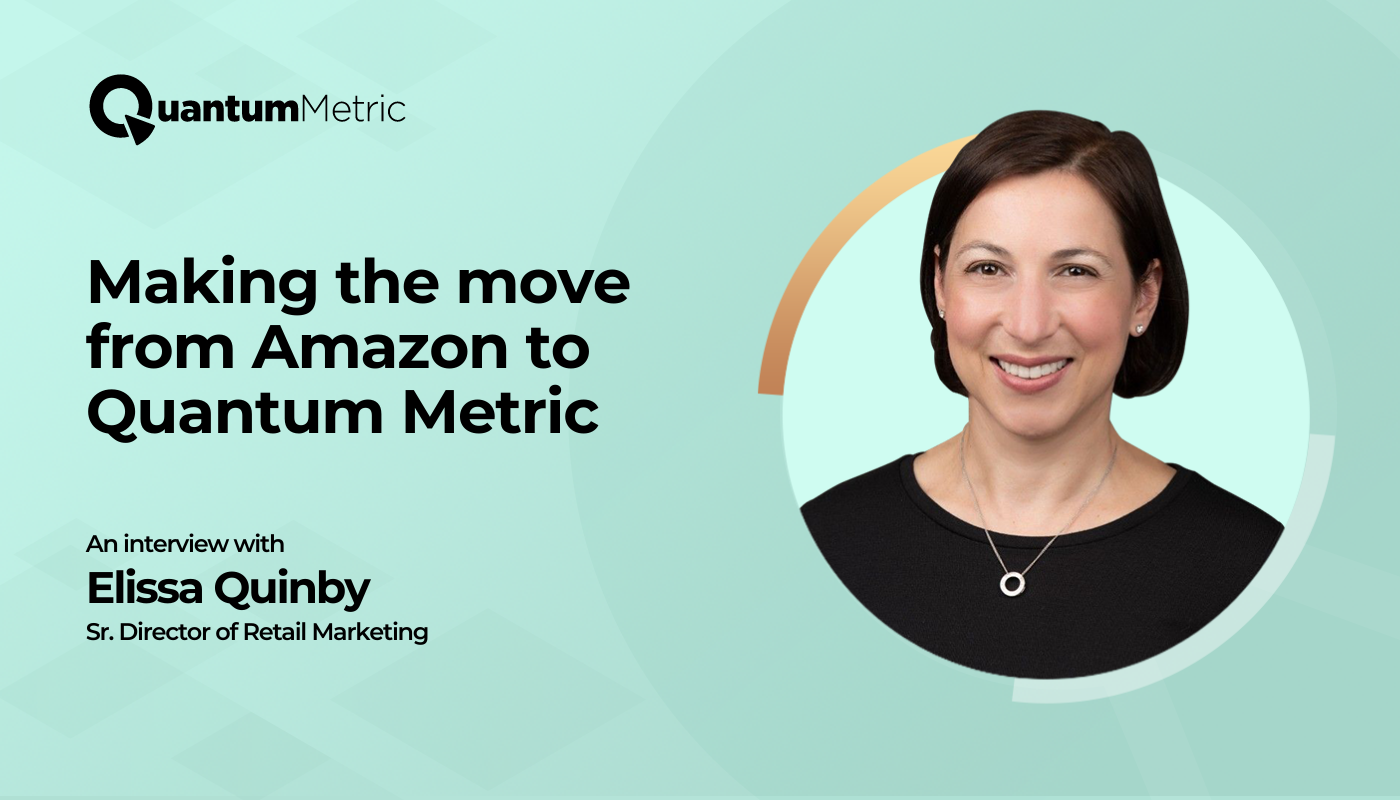Meet the newest member of Quantum Metric.

I spoke with Elissa Quinby, Sr. Director of Retail Marketing at Quantum Metric and former Retail Product Management Leader at Amazon, about her decision to leave her leadership role at Amazon to work at Quantum Metric.
What do Amazon and Quantum Metric have in common?
One of Amazon’s leadership principles – which is a strong area of focus for the company overall – is customer obsession. Similarly, Quantum Metric helps companies across sectors such as retail and financial services manically focus around the customer’s needs and wants.
At Amazon, the digital teams work together to eliminate customer pain points in order to raise the bar on the customer experience. Like Amazon, Quantum Metric’s goal is to help make companies across a number of verticals–travel, retail, financial services, and retail banking, to name a few – more customer centric through data-driven decision making.
Amazon embraces a culture of “test and learn,” which means continuously testing new features and making changes. Similarly, QM equips companies with the necessary technology to make decisions based on a single source of quantitative and qualitative (e.g., session replay) truths. In other words: QM helps companies quantify the business impact of each new feature, design decision, and backlog item. This takes the guesswork out of deciding which new features and products to build.
What about their culture?
Across Amazon, employees followed 16 Leadership Principles (including “Customer Obsession” and “Learn and Be Curious”) daily. They are the guiding force behind everything that the company does.
QM has 3 core values: Passion, Persistence, and Integrity. During the recruiting process, I really admired how the team embraced its core values and put them into action daily.
The cultures at Amazon and QM lead to success because employees at both companies focus on empathizing with, and obsessing around, the customer by making decisions backed by data.
How did you help customers have better digital experiences?
I ran a product team at Amazon, where our goal was to improve the customer CX. We spent all day, every day, developing ways to 1) remove friction points that customers face throughout their shopping journey 2) as well as surprising and delighting them with intuitive user experiences at specific intersections while shopping.
At QM, my goal is to help other companies bring this process to life for their customers too.
It sounds like you’ve been “in the trenches” of digital customer experience. Can you share some lessons you learned or key reflections?
*Laughs*
Yes. You can definitely say that. Some lessons or reflections would include:
1. Use insight on customer behavior to pinpoint frustrations before they complain.
Session replay, for example, is a great way to step into the customer’s shoes and foster empathy. This technology can help you brainstorm ways to fix problems related to design features – problems that are not picked up by traditional analytics tools, like Google Analytics.
2. Leverage data to prioritize your organization’s time and resources.
This means investing in the features and products that matter most to your customers, as well as the business’s bottom line.
A company’s biggest constraints are hours in the week and butts in seats – you need to ruthlessly prioritize and ensure the projects you pick have the highest customer impact.
If your team pours hours and dollars into an amazing new product that no one uses, are you giving your customers the best experience? No! Because it’s not providing any business value.
3. Experiment and optimize!
It’s important to learn, iterate and even fail fast. Organizations will accomplish more by making iterative changes quickly rather than pushing out larger changes that take longer to implement. Teams learn faster by experimenting with smaller iterations; this enables them to improve the customer experience at a much faster rate.
What are some of the big trends for digital retailers that Amazon put into motion?
Amazon started the digital revolution over 20 years ago, when Jeff Bezos started drawing out his virtuous cycle; the company continues to focus on its “working backwards” principles.
Amazon built its retail strategy around selection, price, and convenience. All three will continue to be important, especially as Covid-19 continues.
For selection, Amazon is the leader of the “one-stop-shop.”
People are continuing to spend more time at home, which means they are evaluating what they will keep from their new Covid-19 lifestyles. Brands, especially DTC retailers, have an opportunity to provide unique and compelling selection/assortment workflows that meet customers’ needs as their digital behaviors and lifestyles continue to evolve.
On the convenience side, Amazon has set the bar for fast shipping – usually 1-2 days. In response, other retailers have developed other hybrid methods of shopping such as BOPIS (buy online pickup in-store) or contactless delivery. Those trends will continue and retailers need to optimize how to make these methods better for customers.
Mobile is becoming an increasingly important trend for retailers. There’s no question that consumers are moving between multiple platforms and devices, but the importance of mobile first will only continue especially with younger audiences. Retailers need to be mobile first and continue to focus on this over desktop.
Interested in learning how QM is helping retailers achieve Amazon-level obsession around the customer? Join Elissa Quinby on Wednesday, Sept. 1 at 11am ET (9am MT, 8am PT, 4pm BST) for a webinar, 3 Ways to Embrace Agile Retail and Out-Innovate Amazon This Holiday.
Register here.








